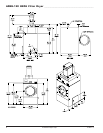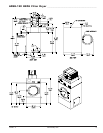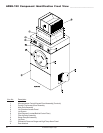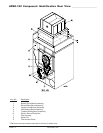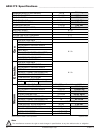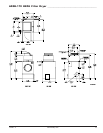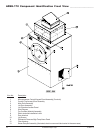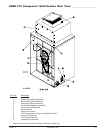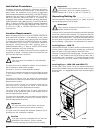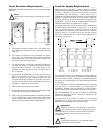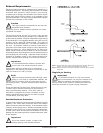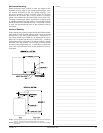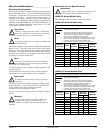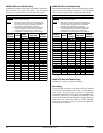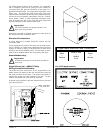
16 American Dryer Corp. 113247-3
Installation Procedures _______________
Installation should be performed by competent technicians
in accordance with local and state codes. In the absence of
these codes, the installation must conform to applicable
American National Standards: ANSI Z223.1-LATEST EDITION
(National Fuel Gas Code) or ANSI/NFPA NO. 70-LATEST
EDITION (National Electrical Code) or in Canada, the
installation must conform to applicable Canadian Standards:
CAN/CGA-B149.1-M91 (Natural Gas) or CAN/CGA-B149.2-
M91 (L.P. Gas) or LATEST EDITION (for General Installation
and Gas Plumbing) or Canadian Electrical Codes Parts 1 &
2 CSA C22.1-1990 or LATEST EDITION (for Electrical
Connections).
Location Requirements _______________
Before installing the dryer, be sure the location conforms to
local codes and ordinances. In the absence of such codes
or ordinances the location must conform with the National
Fuel Gas Code ANSI.Z223.1 LATEST EDITION, or in Canada,
the installation must conform to applicable Canadian
Standards: CAN/CGA-B149.1-M91 (Natural Gas) or
CAN/CGA-B149.2-M91 (L.P. Gas) or LATEST EDITION (for
General Installation and Gas Plumbing).
The dryer must be installed on a sound level floor capable of
supporting its weight. Carpeting must be removed from the
floor area that the dryer is to rest on.
Important
“The dryer must be installed on noncombustible
floors only.”
The dryer must not be installed or stored in an area where it
will be exposed to water and/or weather.
The dryer is for use in noncombustible locations.
Provisions for adequate air supply must be provided as noted
in this manual (refer to Fresh Air Supply Requirements
section).
Clearance provisions must be made from combustible
construction as noted in this manual (refer to Dryer Enclosure
Requirements section).
Provisions must be made for adequate clearances for
servicing and for operation as noted in this manual
(refer to Dryer Enclosure Requirements section).
The dryer must be installed with a proper exhaust duct
connection to the outside as noted in this manual (refer to
Exhaust Requirements section).
The dryer must be located in an area where correct exhaust
venting can be achieved as noted in this manual (refer to
Exhaust Requirements section).
Impor tant
The dryer should be located where a minimum
amount of exhaust ducting will be necessary.
The dryer must be installed with adequate clearance for air
openings into the combustion chamber.
Caution
This dryer produces combustible lint and must be
exhausted to the outdoors. Every 6 months,
inspect the exhaust ducting and remove any lint buildup.
Important
The dryer must be installed in a location/
environment, which the ambient temperature
remains between 40° F (4.44° C) and 130° F (54.44° C).
Unpacking/Setting Up _________________
Remove protective shipping material (i.e., plastic wrap and
optional shipping box) from the dryer.
Important
Dryer must be transported and handled in an
upright position at all times.
The dryer can be moved to its final location while still attached
to the skid or with the skid removed. To remove the skid from
the dryer, locate and remove the 4 bolts securing the base of
the dryer to the wooden skid. 2 are at the rear base (remove
the back panel for access) and 2 are located in the bottom of
the lint chamber. (Remove the lint drawer/door for access.)
Leveling Dryer – ADH-75
With the skid removed, to make it easier to slide the dryer into
its final position, slightly lower all 4 leveling legs, so that the
dryer will slide on the legs instead of the base frame.
The dryer is equipped with 4 leveling legs, 1 at each corner of
the base. 2 are located at the rear of the dryer base, and 2
are located in the lint chamber. To increase bearing life and
improve efficiency, the dryer should be tilted slightly to the
rear.
Leveling Dryer – ADH-120 and ADH-170
To level dryer, place 4-inch (10.16 cm) square metal shims
(refer to the illustration below) or other suitable material under
the base pads. It is suggested that the dryer be tilted slightly
to the rear.
!
!
!
!
!



